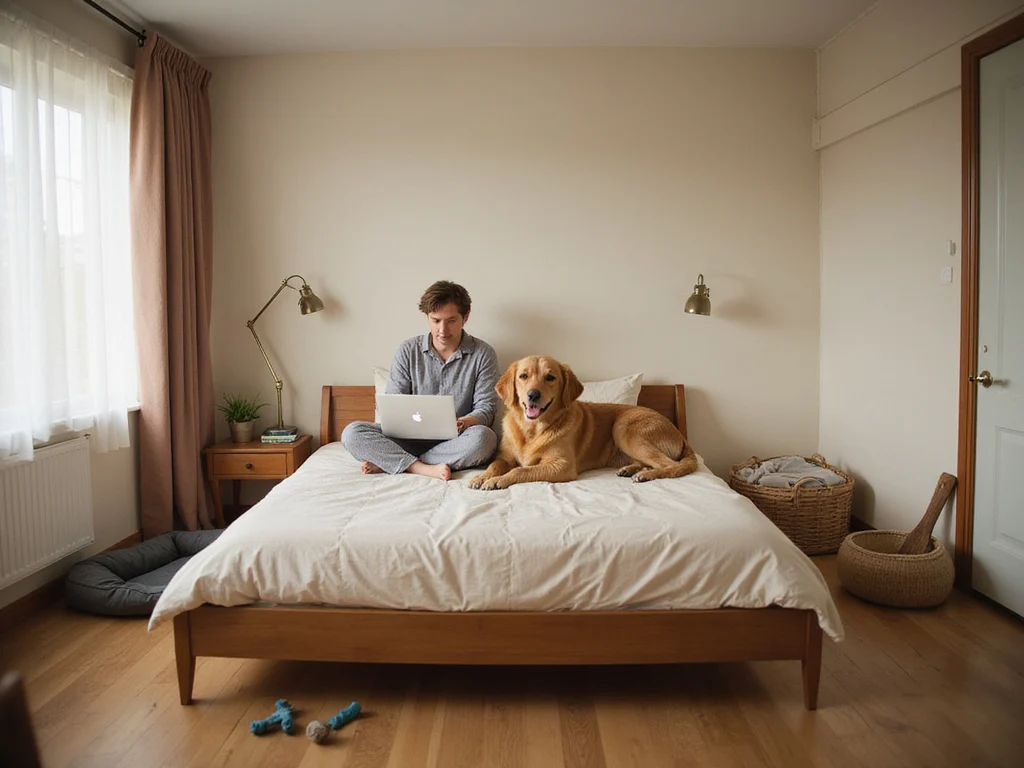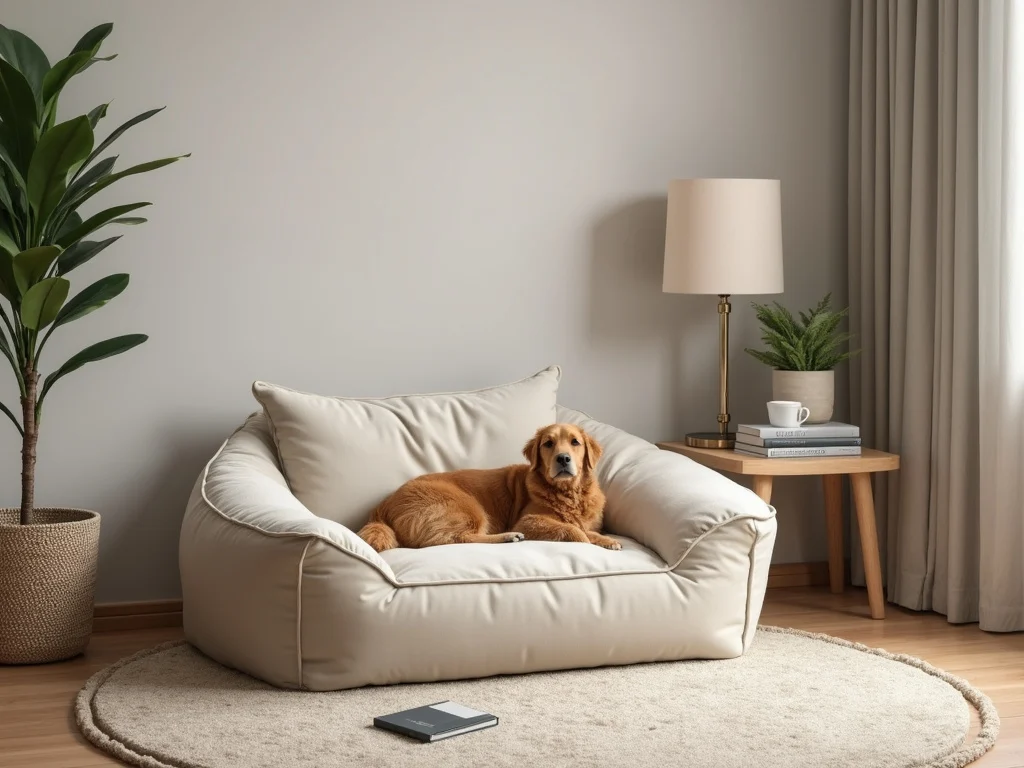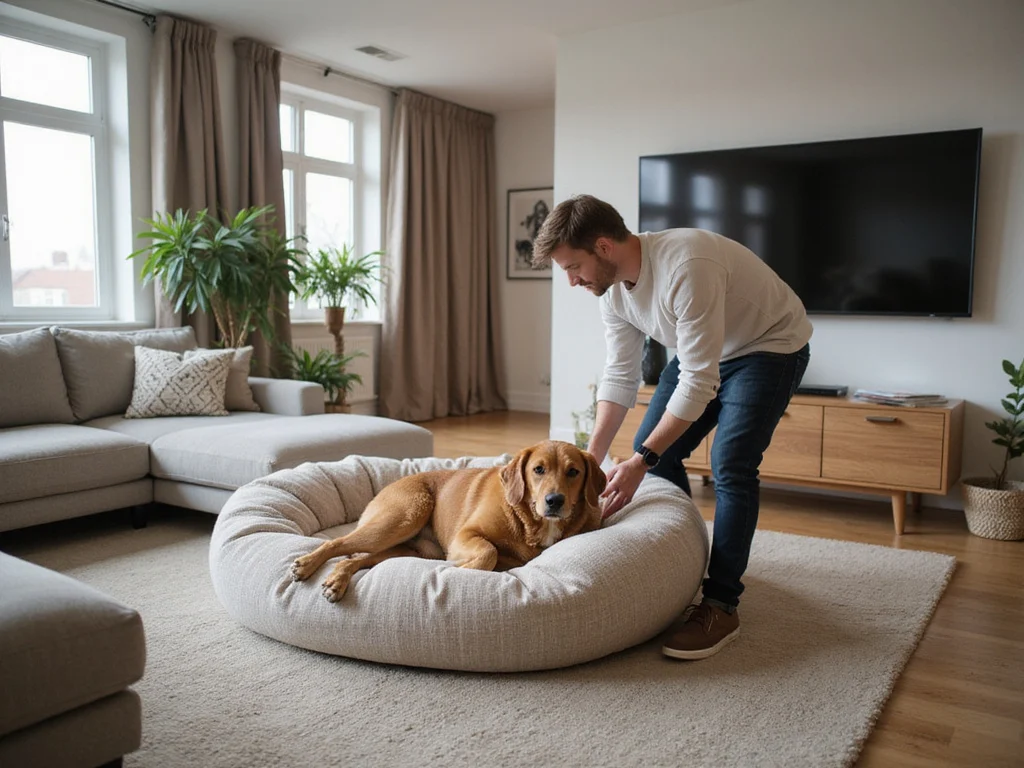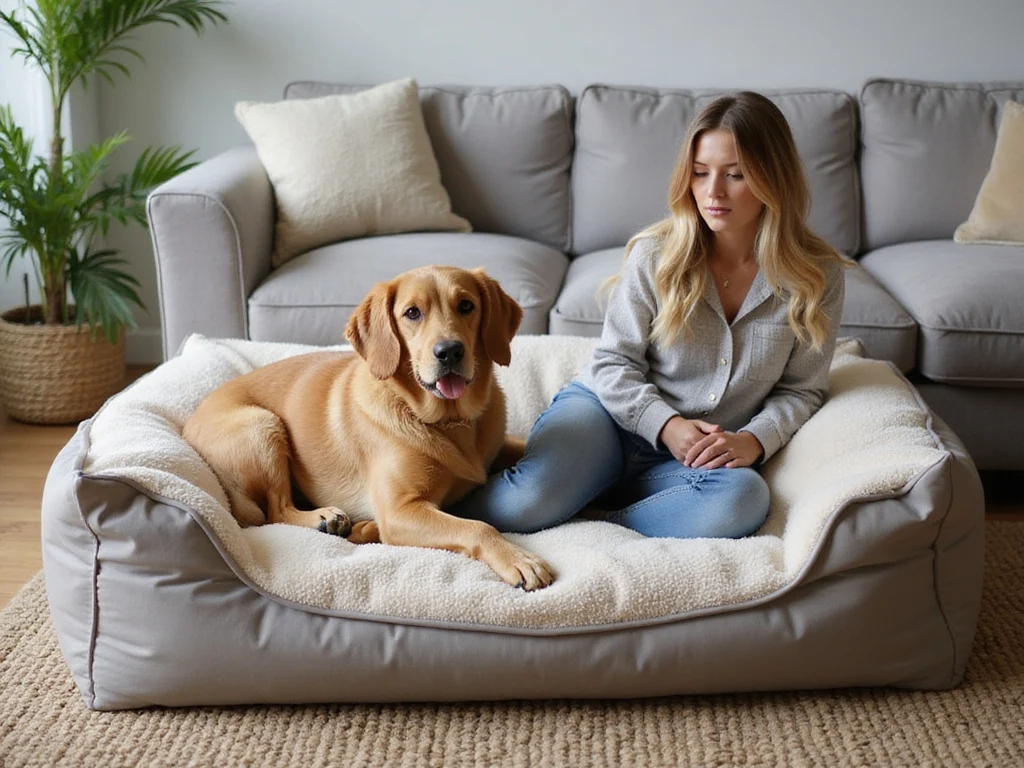The Ultimate Guide to Human Dog Beds: Comfort, Benefits, and Shopping Tips
In recent years, pet owners have been looking for innovative ways to enhance the bond with their furry companions while ensuring maximum comfort for both themselves and their pets. Enter the human dog bed – a revolutionary concept that’s changing how we share space with our canine friends. Whether you’re considering a DIY project to create your own oversized dog bed that humans can enjoy too, or you’re shopping for a commercially available option like the popular Plufl, this comprehensive guide will walk you through everything you need to know about this growing trend in pet accessories.
What Exactly Is a Human Dog Bed?
A human dog bed is exactly what it sounds like – a bed designed with the comfort features of a traditional dog bed but sized for human use. These beds typically feature plush bolsters around the edges, ultra-soft cushioning, and a design that allows for curling up in a cozy, nest-like environment. The concept bridges the gap between human comfort and the instinctive security that dogs find in their own beds.
The most recognized commercial version is the Plufl, which claims to be “the world’s first dog bed for humans.” It features 360-degree plush pillow bolsters that cradle the body and provide unprecedented comfort and support. The design mimics traditional dog beds but scaled up significantly to accommodate adult humans who want to experience the same snug, enclosed feeling that dogs enjoy in their beds.
Benefits of Human Dog Beds: Why Are They Gaining Popularity?
Stress Reduction and Anxiety Relief
One of the primary benefits of human dog beds is their potential for reducing stress and anxiety. The encompassing design creates a sense of security that can help calm an overactive nervous system. Many users report that the feeling of being “held” by the bolsters produces a calming effect similar to weighted blankets or deep pressure therapy. For individuals with anxiety disorders, sensory processing issues, or those who simply enjoy the feeling of being cradled, these beds offer a unique form of comfort that traditional mattresses can’t provide.
Improved Rest and Relaxation
The ergonomic design of human dog beds can actually improve the quality of rest for many people. The cushioned bolsters provide excellent support for the spine, neck, and limbs, potentially alleviating pressure points and allowing for deeper relaxation. The enclosed nature of these beds also minimizes tossing and turning, which can lead to more restful sleep or napping sessions. For individuals who struggle with conventional sleeping arrangements, a human dog bed might offer an alternative that better suits their comfort needs.
Enhanced Bonding with Pets
Perhaps the most appealing aspect of human dog beds for pet owners is the opportunity they provide for bonding with their furry friends. Many dogs naturally seek out their owner’s beds for comfort and closeness, but space constraints and hygiene concerns can make sharing a traditional bed problematic. A human dog bed creates a dedicated space where both human and canine can comfortably rest together. This shared experience can strengthen the human-animal bond and provide comfort to both parties. For dogs with separation anxiety, having a specific space where they can safely cuddle with their owners can be especially beneficial.
DIY Human Dog Bed: Creating Your Own Cozy Haven
If you’re crafty and looking to save some money, creating your own human dog bed can be a rewarding project. The basic concept involves scaling up a traditional dog bed design to accommodate a human. Here’s a step-by-step guide to help you get started.
Materials Needed for a DIY Human Dog Bed
- Foam mattress or high-density foam (at least 4-6 inches thick)
- Durable upholstery fabric (approximately 5-6 yards, depending on your bed size)
- Pillow stuffing or foam tubes for bolsters
- Waterproof liner or fabric (optional but recommended)
- Zipper (heavy-duty, at least 30-40 inches long)
- Thread matching your fabric
- Sewing machine (though hand-sewing is possible for determined DIYers)
- Scissors, pins, measuring tape, and other basic sewing supplies
Step-by-Step Construction Guide
- Determine your dimensions: Measure yourself in a curled-up position to ensure your bed will be large enough. Most human dog beds range from 36-48 inches in diameter.
- Cut your foam base: Cut your foam mattress or high-density foam to your desired shape (usually round or oval).
- Create your bolsters: Cut foam tubes or use pillow stuffing to create the bolster cushions that will surround the bed.
- Cut your fabric: You’ll need pieces for the top, bottom, bolsters, and inner sides.
- Sew the bolster cover: Create a tube shape with one end closed, then stuff with your filling.
- Attach the bolster to the base: Sew the bolster to the outer edge of your base fabric.
- Add a zipper: Install a zipper so you can remove the cover for washing.
- Complete the cover: Sew the bottom fabric to the top/bolster assembly, leaving the zipper open for turning right-side out.
- Insert the foam base and finalize: Turn the cover right-side out, insert your foam base, and close the zipper.
Eco-Friendly Options for DIY Human Dog Beds
For environmentally conscious pet owners, there are several ways to make your DIY human dog bed more eco-friendly:
- Use organic cotton or hemp fabrics which are grown without pesticides and have a lower environmental impact
- Choose recycled polyester filling made from post-consumer plastic bottles
- Look for natural latex foam as an alternative to petroleum-based foam products
- Consider upcycling old mattresses or cushions for the filling instead of buying new materials
- Use natural dyes if you want to color your fabric
- Opt for biodegradable thread made from cotton or other natural fibers
By choosing sustainable materials, you can create a comfortable human dog bed while minimizing your environmental footprint.
Commercial Options: Popular Human Dog Beds to Buy
If DIY isn’t your thing, there are several commercial options available for those interested in purchasing a ready-made human dog bed:
The Plufl Original Human Dog Bed
The Plufl is the most well-known human dog bed on the market. It features a premium orthopedic memory foam base and 360-degree plush pillow bolsters that provide exceptional comfort and support. The cover is made from faux fur and is machine washable for easy maintenance. Users rave about the comfort level, with many reporting improved napping experiences and stress relief. The Plufl is designed to accommodate most adults comfortably and comes in several color options to match your home decor. The brand has gained significant attention on social media platforms like TikTok, where users share their experiences with this innovative product.
PETIQUE Bedside Lounge Pet Bed
While not strictly marketed as a human dog bed, the PETIQUE Bedside Lounge is a stylish option for those looking for a bed attachment solution. This bed features a contemporary design with a zebra print pattern that can add a fun touch to your home decor. The comfortable padding provides a cozy resting place for pets while keeping them close to their owners. Although designed primarily for pets, some users report that they can comfortably sit or lounge in these beds alongside their smaller dogs. This option is ideal for those who want the closeness of bed-sharing without the full commitment to a human-sized dog bed.
Sleepy Hippo Frame Bedside Pet Bed
The Sleepy Hippo Frame is a beautifully crafted solid wood frame designed to attach to the side of your bed, creating an extension for your pet. While this isn’t a traditional human dog bed, it provides a solution for pet owners who want to keep their dogs close while sleeping. The frame can be customized with your choice of cushion or mattress, allowing for personalization based on both human and canine comfort preferences. The elegant design makes it a stylish addition to any bedroom, and the solid construction ensures durability and stability.
Dog Bed Extensions for Human Beds: The Best of Both Worlds
If you’re not quite ready to commit to a full human dog bed but want to create a comfortable sleeping arrangement that keeps your pet close, dog bed extensions for human beds offer an excellent compromise. These products attach directly to your existing bed, creating a dedicated space for your dog without requiring you to give up your mattress.
Benefits of Dog Bed Extensions
- Space optimization: They don’t require additional floor space beyond your existing bed footprint
- Proximity without disruption: Keeps your pet close without them disturbing your sleep by moving around on your mattress
- Independence with security: Gives your dog their own space while still allowing them to feel secure near you
- Cleanliness: Reduces the amount of pet hair and dander in your bedding
- Training aid: Can help transition dogs who are used to sleeping in the human bed to their own sleeping space
Top Dog Bed Extension Options
Several quality options are available for those interested in dog bed extensions:
- ZAOWU Cat Hammock Bed: Despite its name, this plush nap mat with a wire bed frame works well for small dogs too. Its hammock-style design attaches securely to the side of your bed, providing a cozy resting spot that keeps your pet at your level.
- Penn-Plax Buddy Bunk Multi-Level Bed: This innovative design features a 3-step system that allows pets to climb up to a platform that sits level with your mattress. It’s ideal for smaller dogs and cats who might struggle to jump directly onto high beds.
- DoggySnooze snoozeSleeper: A sturdy platform bed that can be adjusted to the height of your mattress, providing a seamless extension to your sleeping area that’s perfectly suited for medium to large dogs.
Pros and Cons of Human Dog Beds vs. Dogs in Human Beds
When deciding whether to invest in a human dog bed or simply allow your dog to share your conventional bed, it’s important to weigh the advantages and disadvantages of each approach.
Pros of Human Dog Beds
- Controlled environment: You determine where and when sharing occurs
- Reduced allergies: Keeps pet dander concentrated in one area rather than throughout your bedding
- Better boundaries: Helps establish healthy boundaries with pets who may exhibit dominance behaviors
- Improved sleep quality: Minimizes disruptions from pets moving around during the night
- Easier cleaning: Most human dog beds have removable, washable covers
- Comfort for both: Designed to accommodate both human and canine comfort needs
Cons of Human Dog Beds
- Cost: Quality human dog beds can be expensive, especially compared to simply allowing your dog in your existing bed
- Space requirements: They take up additional floor space in your home
- Adjustment period: Both you and your pet may need time to adapt to the new arrangement
- Limited options: Fewer style and design choices compared to traditional beds
- Potential durability issues: Depending on quality, may not last as long as a traditional mattress
Pros of Dogs in Human Beds
- Convenience: No additional purchases or space required
- Comfort familiarity: Many dogs and owners already prefer this arrangement
- Temperature regulation: Body heat sharing can be beneficial in colder environments
- Immediate proximity: Maximum closeness for bonding
Cons of Dogs in Human Beds
- Sleep disruption: Dogs can move, snore, or take up space inappropriately
- Hygiene concerns: Increased exposure to pet dander, dirt, and potential parasites
- Allergy issues: Can exacerbate allergic reactions to pet dander
- Behavioral reinforcement: May reinforce dominance or anxiety-related behaviors in some dogs
- Space limitations: Particularly problematic with larger dogs or multiple pets
- Cleanliness: More frequent washing of bedding required
Health and Behavioral Considerations
Beyond comfort and convenience, there are important health and behavioral factors to consider when deciding on sleeping arrangements with your dog.
Impact on Sleep Quality
Research has shown mixed results regarding how dogs in beds affect human sleep quality. Some studies suggest that the presence of a dog can help some people sleep better due to increased feelings of security and comfort. However, other research indicates that dogs can disrupt sleep cycles through movement, snoring, or taking up space. Human dog beds offer a compromise – keeping your pet close while minimizing direct sleep disruptions. This arrangement may be particularly beneficial for light sleepers who still want the emotional benefits of sleeping near their pets.
Behavioral Training Implications
Where your dog sleeps can affect their behavior and your relationship dynamics. Dogs who sleep in their owners’ beds may sometimes develop resource guarding or territorial behaviors. They might also struggle with separation anxiety when not allowed in the bed or when the routine changes. Using a human dog bed or bed extension can help establish clearer boundaries while still maintaining closeness. This middle-ground approach allows you to set consistent rules that can prevent or address problematic behaviors while nurturing the human-animal bond.
Hygiene and Allergy Management
For individuals with allergies, direct bed-sharing with pets can significantly worsen symptoms. Dogs bring outdoor allergens, dander, and occasionally parasites into bed linens. Human dog beds provide physical separation that can reduce allergen exposure while still allowing for quality time with your pet. Additionally, most commercial human dog beds feature removable, washable covers that make regular cleaning much easier than washing all of your bedding frequently. For those concerned about cleanliness, a waterproof liner between the foam and exterior fabric can provide additional protection, especially for senior dogs or puppies who might have accidents.
Creating the Perfect Space: Design and Placement Tips
Whether you choose a commercial human dog bed, a DIY project, or a bed extension, thoughtful placement and design integration can enhance both functionality and aesthetics.
Best Locations for Human Dog Beds
- Next to your existing bed: Keeps your pet close without sharing the same surface
- In a cozy corner of your bedroom: Creates a den-like feeling that many dogs prefer
- In a home office: Perfect for keeping your pet company during work hours
- Living room or family room: Allows for cozy lounging during family time
- Sunroom or by a window: Many dogs enjoy basking in natural light while resting
Matching Your Home Decor
Human dog beds don’t have to be eyesores in your carefully designed home. Many commercial options come in stylish colors and fabrics that can complement your existing decor. If creating your own bed, select fabrics that coordinate with your color scheme and overall aesthetic. Consider the bed as a piece of furniture rather than just a pet accessory, and choose materials that will blend seamlessly with your home’s style. Some owners even design custom covers that match their own bedding for a cohesive look.
Maintenance and Cleaning Best Practices
To keep your human dog bed fresh and hygienic:
- Vacuum the bed regularly to remove hair and dander
- Wash removable covers according to manufacturer instructions, typically every 1-2 weeks
- Spot clean non-removable parts with pet-safe cleaners
- Air out the foam base occasionally in a well-ventilated area
- Use a waterproof cover if moisture is a concern
- Consider using a pet-safe fabric refresher between washes
- Place a washable blanket on top for an easy-to-clean layer
Shopping Guide: What to Look for When Buying
If you’re in the market for a commercial human dog bed, keep these factors in mind to ensure you make the best purchase for your needs:
Quality Indicators
- Foam density: Higher density foam provides better support and durability
- Fabric durability: Look for tight weaves and reinforced stitching at seams
- Cover construction: Zippered covers with strong zippers indicate quality construction
- Weight capacity: Ensure the bed can comfortably support your weight
- Warranty: Longer warranties typically indicate manufacturer confidence in the product
Size Considerations
When selecting a human dog bed, size matters significantly. Consider both your dimensions and your dog’s:
- Measure yourself in a curled-up position to ensure adequate space
- Account for your dog’s preferred sleeping position and size
- Consider whether multiple pets will use the bed simultaneously
- Check the depth of the bolsters – taller bolsters provide more support but might make entry/exit challenging for smaller dogs
- Verify that the bed will fit in your intended placement location
Price Points and Value Analysis
Human dog beds vary widely in price, generally ranging from $200 to $500 for commercial options. Higher-priced models typically offer:
- Premium materials like memory foam or orthopedic foam bases
- Higher quality, more durable fabrics
- Better construction techniques that improve longevity
- More generous warranties or return policies
- Additional features like waterproofing or cooling technologies
While it might be tempting to choose the least expensive option, consider the bed as an investment in both your comfort and your pet’s well-being. A quality human dog bed can last for years with proper care, making the higher initial investment more economical in the long run. If budget is a concern, DIY options can provide significant savings while still delivering a comfortable resting space.
Innovations and Future Trends in Human-Pet Sleep Solutions
The market for human dog beds and related products continues to evolve, with several exciting trends on the horizon:
Smart Technology Integration
As smart home technology becomes more prevalent, we’re beginning to see its integration into pet products, including bedding solutions. Some innovative features being developed or already available include:
- Temperature regulation technology that keeps the bed at an optimal comfort level
- Built-in health monitoring sensors that track your pet’s vital signs during rest
- Programmable warming and cooling features that adjust to preferences
- Integration with smart home systems for remote monitoring and control
- Sleep quality analysis for both humans and pets
Advanced Materials Development
Material science advancements are creating exciting possibilities for the next generation of human dog beds:
- Eco-friendly foam alternatives made from sustainable plant sources
- Self-cleaning fabrics that resist bacteria and odor build-up
- Advanced moisture-wicking materials that improve comfort in all seasons
- Allergen-resistant coverings that minimize dander accumulation
- Biodegradable components for reduced environmental impact
Customization Opportunities
The future of human dog beds will likely include greater personalization options:
- Modular designs that can be reconfigured based on needs
- Custom-fitted beds based on 3D body scanning of both pets and owners
- Adjustable firmness settings for different areas of the bed
- Print-on-demand fabric patterns for perfect home decor matching
- Multi-functional designs that convert between different uses
As more people recognize the benefits of quality sleep environments that accommodate both humans and their pets, we can expect continued innovation in this growing product category.
Conclusion: Finding Your Perfect Human-Canine Sleep Solution
The journey to finding the ideal sleeping arrangement for you and your dog is highly personal. Whether you choose a human dog bed, a bed extension, or continue sharing your traditional mattress, the most important factors are comfort, sleep quality, and the strength of your bond with your pet. By carefully considering the pros and cons of each option and evaluating your specific circumstances – including space constraints, allergies, behavioral factors, and personal preferences – you can make an informed decision that enhances your relationship with your furry companion.
Remember that transitioning to any new sleeping arrangement may take time. Be patient with both yourself and your dog as you adapt to changes. The goal is to create a restful environment where both of you feel secure, comfortable, and connected. With the growing variety of options available – from DIY projects to high-tech commercial products – there’s truly a perfect solution for every human-canine partnership.
Frequently Asked Questions About Human Dog Beds
What is a human dog bed and why would I want one?
A human dog bed is an oversized version of a traditional dog bed designed for human use. It typically features cushioned bolsters around the edges and a plush, supportive base. People are drawn to these beds because they offer a unique feeling of security and comfort, similar to what dogs experience in their beds. They’re perfect for relaxation, napping, reading, or simply bonding with your pet in a shared space that’s comfortable for both of you. Many users report reduced anxiety and improved relaxation when using these specialized beds.
What materials do I need to make a DIY human dog bed?
To make a DIY human dog bed, you’ll need high-density foam (4-6 inches thick) for the base, durable upholstery fabric (5-6 yards), pillow stuffing or foam tubes for the bolsters, a heavy-duty zipper (30-40 inches), matching thread, and basic sewing supplies. Optional materials include a waterproof liner for protection against spills or accidents, and eco-friendly alternatives like organic cotton fabric, natural latex foam, or recycled polyester filling if sustainability is important to you. While a sewing machine makes the project easier, determined crafters can complete it with hand-sewing techniques.
How do dog bed extensions for human beds work?
Dog bed extensions attach directly to your existing bed frame or mattress, creating a dedicated sleeping space for your pet that’s level with your bed. These extensions typically use brackets, straps, or custom frames to securely connect to your bed structure. They provide the closeness many pet owners desire without the sleep disruptions that can occur when sharing the same sleep surface. Popular options include the ZAOWU Cat Hammock Bed (which works for small dogs too), the Penn-Plax Buddy Bunk with its step system, and the Sleepy Hippo Frame made from solid wood. These extensions are ideal for pet owners with limited space or those looking to transition their dogs off the human mattress gradually.
Can sharing a bed with my dog cause behavioral issues?
Yes, allowing your dog to share your bed can potentially reinforce certain behavioral issues in some cases. Dogs may develop resource guarding behaviors around the bed, viewing it as their territory to protect. This can manifest as growling, snapping, or reluctance to move when asked. Some dogs may also develop separation anxiety if they become too accustomed to constant nighttime proximity with their owners. Additionally, the bed-sharing arrangement can confuse the pack hierarchy for some dogs, potentially leading to dominance issues in other aspects of your relationship. Human dog beds or bed extensions can provide a good compromise, maintaining closeness while establishing clearer boundaries.
What should I look for when purchasing a commercial human dog bed?
When shopping for a commercial human dog bed, prioritize quality construction, appropriate size, and materials that suit your needs. Look for high-density foam (at least 4-6 inches thick) for proper support, durable upholstery-grade fabric that can withstand both human and dog use, and strong stitching at the seams. Ensure the dimensions accommodate your size when curled up comfortably. Removable, machine-washable covers are essential for hygiene maintenance. Consider whether you need waterproofing features, particularly if you have senior dogs or puppies. Check the weight capacity to ensure it’s appropriate for your body type. Finally, review the warranty terms and customer reviews to assess long-term durability and customer satisfaction before making your purchase.
How do I maintain and clean my human dog bed?
To keep your human dog bed clean and fresh, establish a regular maintenance routine. Vacuum the bed weekly to remove hair, dander, and debris. Wash removable covers according to manufacturer instructions, typically every 1-2 weeks or more frequently if your dog sheds heavily. For non-removable parts or between deep cleanings, use pet-safe fabric refreshers or deodorizers. Spot clean stains immediately with appropriate cleaners based on the fabric type. If your bed has foam components, air them out occasionally in a well-ventilated area to prevent moisture buildup. Consider using a washable blanket as an additional protective layer that can be laundered more frequently. For beds with waterproof liners, check periodically to ensure the waterproofing remains effective and replace if necessary.
Looking for more information about dog beds and pet comfort solutions? Visit Cactus Lands for additional DIY guides and product recommendations to enhance your pet care experience.



